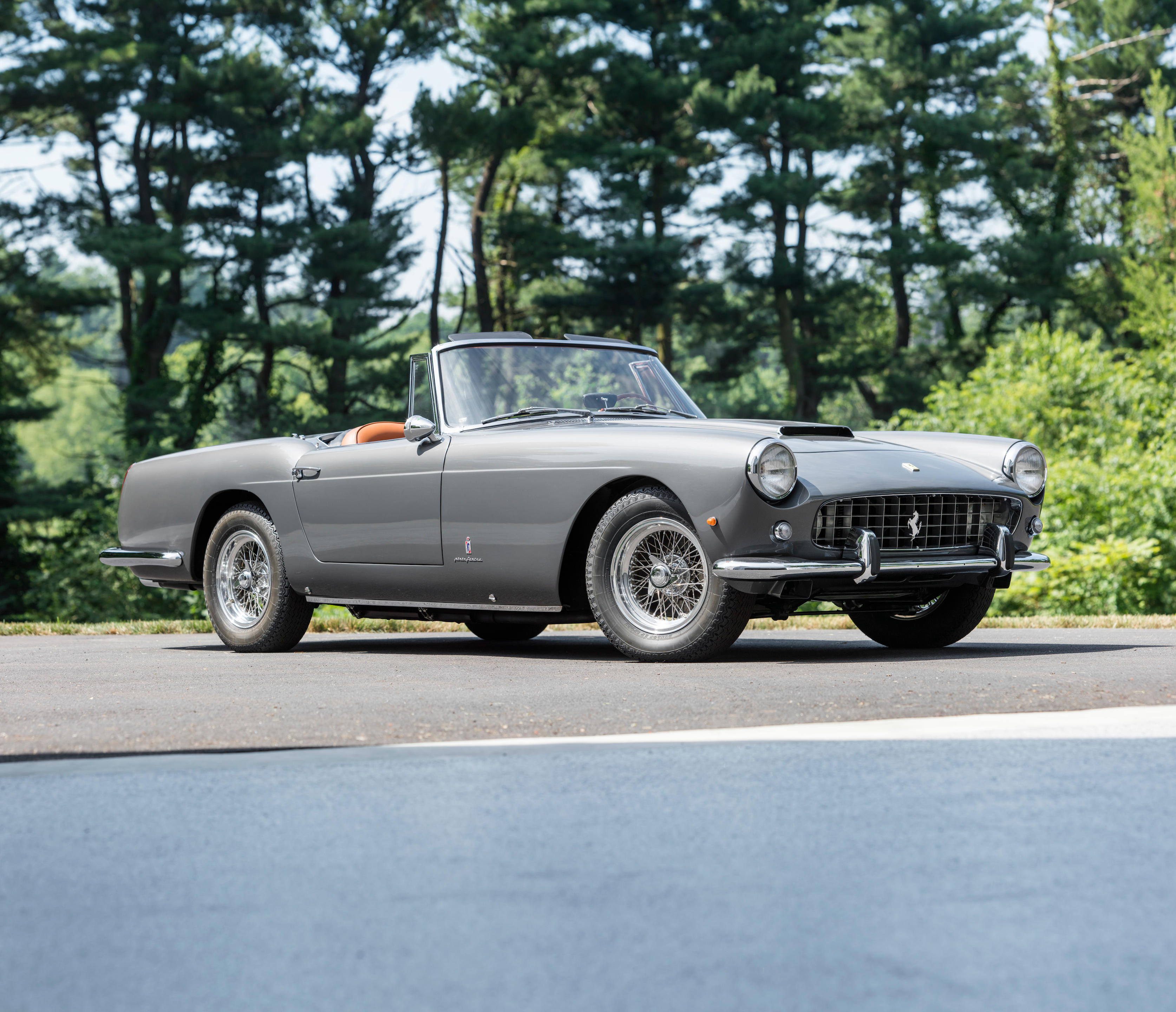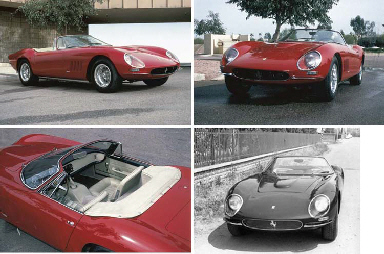Delivered new to Jean Blaton 'Beurlys' in Belgium via Jacques Swaters' Garage Francorchamps 1960 Ferrari 250 GT Series II Cabriolet Coachwork by Pininfarina Chassis no. 2071 GT Engine no. 2071 GT •1 of only 100 Series II examples with disc brakes from new •Unique coachwork boasting special-ordered '410 Superamerica side vents' •Matching numbers example •Long-term previous ownership (32 years) •Recent bare metal respray to a high standard •Marcel Massini report on file Fußnoten By the early 1960s, road car production had ceased to be a sideline for Ferrari and was seen as vitally important to the company's future stability. Thus the 250, Ferrari's first volume-produced model, can be seen as critically important, though production of the first of the line - the 250 Europa, built from 1953 to '54 - amounted to fewer than 20. Before the advent of the Europa, Ferrari had built road-going coupés and convertibles in small numbers, usually to special customer order using a sports-racing chassis as the basis. Ghia and Vignale of Turin and Touring of Milan were responsible for bodying many of these but there was no attempt at standardisation for series production and no two cars were alike. The introduction of the 250 Europa heralded a significant change in Ferrari's preferred coachbuilder; whereas previously Vignale had been the most popular carrozzeria among Maranello's customers, from now on Pinin Farina (later 'Pininfarina') would be Ferrari's number one choice, bodying no fewer than 48 out of the 53 Europa/Europa GTs built. Pinin Farina's experiments eventually crystallised in a new Ferrari 250 GT road car that was first displayed publicly at the Geneva Salon in March 1956. However, the Torinese Carrozzeria was not yet in a position to cope with the increased workload, resulting in production being entrusted to Carrozzeria Boano after Pinin Farina had completed a handful of prototypes. The 250 GT featured the lighter and more compact Colombo-designed 3.0-litre V12 in place of its predecessor's bulkier Lampredi unit. Power output of the single-overhead-camshaft all-aluminium engine was 220bhp at 7,000rpm. Shorter in the wheelbase (by 200mm) than that of the Europa, the 250 GT chassis followed Ferrari's established practice, being a multi-tubular frame tied together by oval main tubes, though the independent front suspension now employed coil springs instead of the previous transverse leaf type. A four-speed all-synchromesh gearbox transmitted power to the live rear axle, while braking was looked after by hydraulic drums all round. True series production began with the arrival of Pininfarina's 'notch back' Coupé on the 250 GT chassis, some 353 of which were built between 1958 and 1960 within the sequence '0841' to '2081'. However, the relatively small scale of production meant that cars could still be ordered with subtle variations according to customer choice, as well as enabling a handful of show cars and 'specials' to be constructed on the 250 GT chassis. A number of prominent European coachbuilders offered a variety of body styles on the 250 GT chassis, with Scaglietti and Pininfarina producing elegant open-top spyder and cabriolet models. Exhibited at the 1957 Geneva Salon, the latter's first 250 GT Cabriolet, which, unusually, featured a Vintage-style cut-down driver's door, was snapped up by Ferrari works driver Peter Collins who later had the car converted to disc brakes. After a handful of alternative versions had been built, series production began in July 1957, around 40 Series I Pininfarina Cabriolets being completed before the introduction of the Series II in 1959. Effectively an open-top version of the Pininfarina-built 250 GT Coupé, whose chassis and mechanicals it shared, the Cabriolet was built alongside its closed cousin until 1962. Overall design followed that of the Coupé, with short nose and long rear overhang, while a more-vertical windscreen provided greater headroom in the generously sized cockpit. As well as
Delivered new to Jean Blaton 'Beurlys' in Belgium via Jacques Swaters' Garage Francorchamps 1960 Ferrari 250 GT Series II Cabriolet Coachwork by Pininfarina Chassis no. 2071 GT Engine no. 2071 GT •1 of only 100 Series II examples with disc brakes from new •Unique coachwork boasting special-ordered '410 Superamerica side vents' •Matching numbers example •Long-term previous ownership (32 years) •Recent bare metal respray to a high standard •Marcel Massini report on file Fußnoten By the early 1960s, road car production had ceased to be a sideline for Ferrari and was seen as vitally important to the company's future stability. Thus the 250, Ferrari's first volume-produced model, can be seen as critically important, though production of the first of the line - the 250 Europa, built from 1953 to '54 - amounted to fewer than 20. Before the advent of the Europa, Ferrari had built road-going coupés and convertibles in small numbers, usually to special customer order using a sports-racing chassis as the basis. Ghia and Vignale of Turin and Touring of Milan were responsible for bodying many of these but there was no attempt at standardisation for series production and no two cars were alike. The introduction of the 250 Europa heralded a significant change in Ferrari's preferred coachbuilder; whereas previously Vignale had been the most popular carrozzeria among Maranello's customers, from now on Pinin Farina (later 'Pininfarina') would be Ferrari's number one choice, bodying no fewer than 48 out of the 53 Europa/Europa GTs built. Pinin Farina's experiments eventually crystallised in a new Ferrari 250 GT road car that was first displayed publicly at the Geneva Salon in March 1956. However, the Torinese Carrozzeria was not yet in a position to cope with the increased workload, resulting in production being entrusted to Carrozzeria Boano after Pinin Farina had completed a handful of prototypes. The 250 GT featured the lighter and more compact Colombo-designed 3.0-litre V12 in place of its predecessor's bulkier Lampredi unit. Power output of the single-overhead-camshaft all-aluminium engine was 220bhp at 7,000rpm. Shorter in the wheelbase (by 200mm) than that of the Europa, the 250 GT chassis followed Ferrari's established practice, being a multi-tubular frame tied together by oval main tubes, though the independent front suspension now employed coil springs instead of the previous transverse leaf type. A four-speed all-synchromesh gearbox transmitted power to the live rear axle, while braking was looked after by hydraulic drums all round. True series production began with the arrival of Pininfarina's 'notch back' Coupé on the 250 GT chassis, some 353 of which were built between 1958 and 1960 within the sequence '0841' to '2081'. However, the relatively small scale of production meant that cars could still be ordered with subtle variations according to customer choice, as well as enabling a handful of show cars and 'specials' to be constructed on the 250 GT chassis. A number of prominent European coachbuilders offered a variety of body styles on the 250 GT chassis, with Scaglietti and Pininfarina producing elegant open-top spyder and cabriolet models. Exhibited at the 1957 Geneva Salon, the latter's first 250 GT Cabriolet, which, unusually, featured a Vintage-style cut-down driver's door, was snapped up by Ferrari works driver Peter Collins who later had the car converted to disc brakes. After a handful of alternative versions had been built, series production began in July 1957, around 40 Series I Pininfarina Cabriolets being completed before the introduction of the Series II in 1959. Effectively an open-top version of the Pininfarina-built 250 GT Coupé, whose chassis and mechanicals it shared, the Cabriolet was built alongside its closed cousin until 1962. Overall design followed that of the Coupé, with short nose and long rear overhang, while a more-vertical windscreen provided greater headroom in the generously sized cockpit. As well as















Testen Sie LotSearch und seine Premium-Features 7 Tage - ohne Kosten!
Lassen Sie sich automatisch über neue Objekte in kommenden Auktionen benachrichtigen.
Suchauftrag anlegen